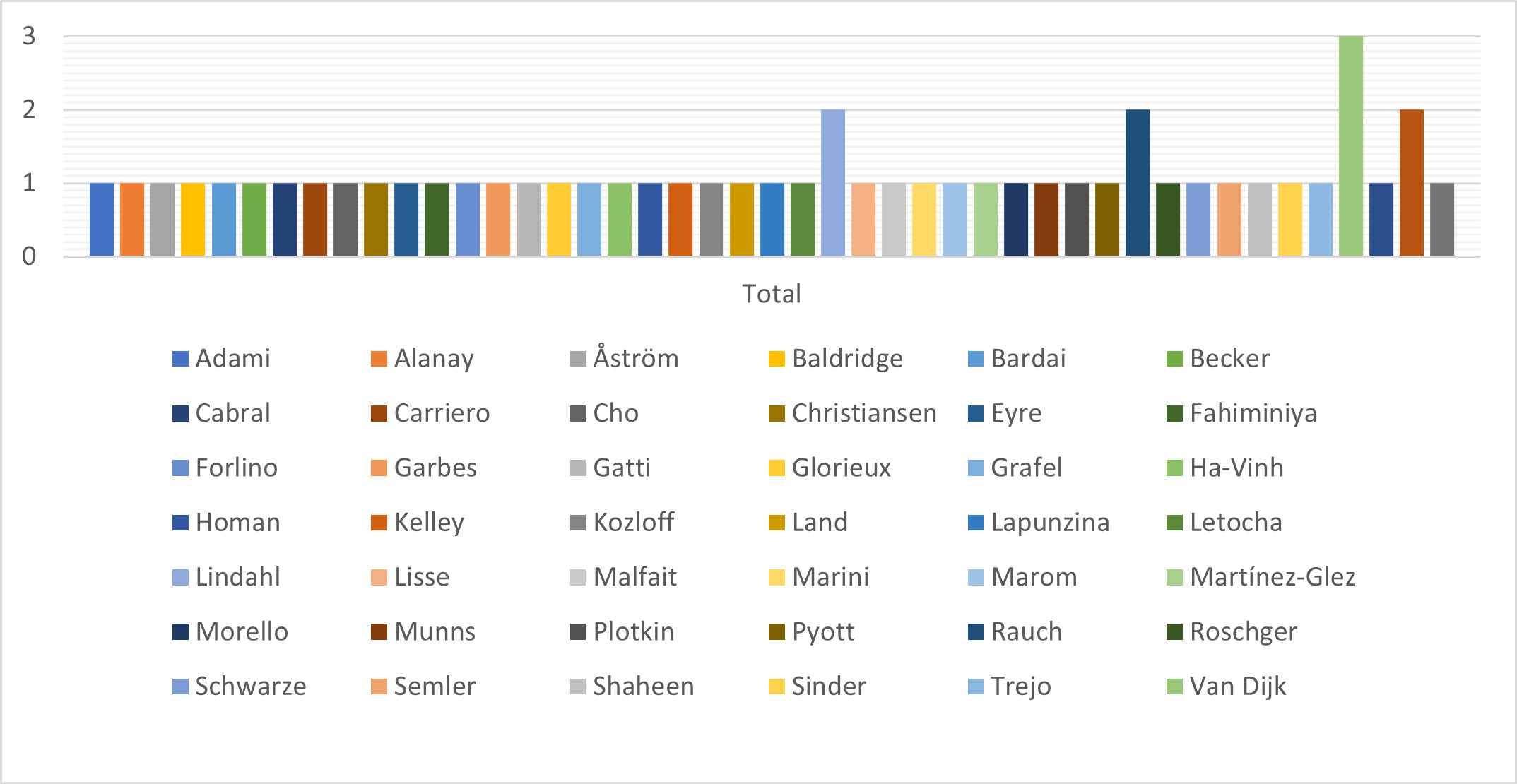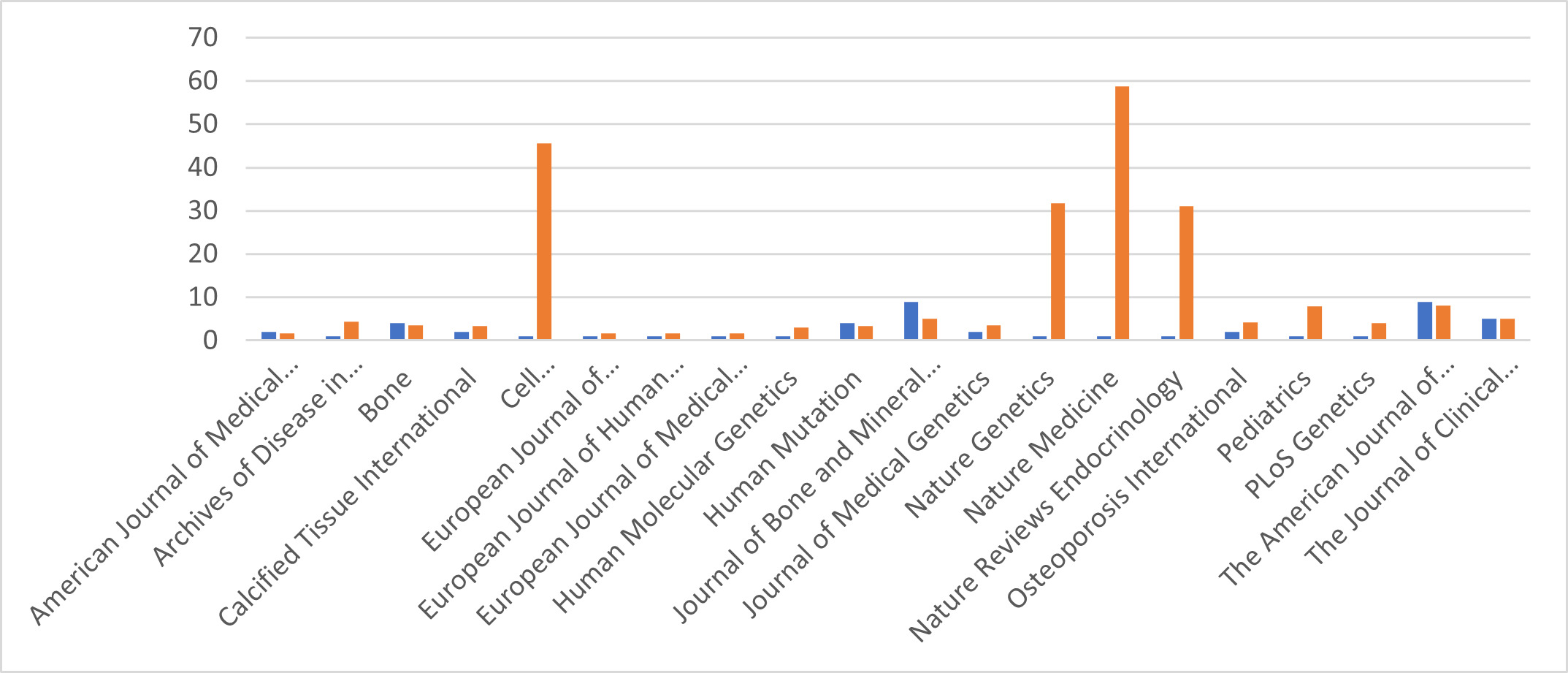Introduction
Osteogenesis imperfecta (OI), also known as brittle bone disease, is a rare inherited genetic disorder characterized by increased bone fragility and low bone mass.1 The incidence of OI ranges from 1 in 10,000 to 20,000 live births. Its pathogenesis primarily involves mutations affecting type I collagen synthesis, particularly in the COL1A1 or COL1A2 genes, which encode the α-chains of type I collagen.2 Clinical manifestations vary from mild bone fragility to perinatal lethality, depending on the OI type. Common features include frequent bone fractures, dentinogenesis imperfecta, blue sclerae, hearing loss, joint laxity, and short stature. Radiological findings often reveal osteopenia, bowing of long bones, and Wormian bones in the skull. Diagnosis is established clinically, supported by family history and radiographic findings. Definitive diagnosis relies on genetic testing, and in selected cases, bone biopsy and biochemical analysis of collagen production may be employed.1,3
Bibliometric analysis statistically evaluates scientific outputs to assess the impact, structure, and trends of scholarly publications within a field. It has gained popularity for managing and interpreting large volumes of scientific data, identifying research gaps, monitoring shifts in focus, mapping the intellectual landscape, and prioritizing directions for clinical and scientific advancement.4 Given the growing volume of OI publications, bibliometric analysis is increasingly necessary. This study aims to identify and evaluate the most cited articles on OI, highlight the most influential authors, institutions, and journals, and assess the quality of the included studies. Additionally, it seeks to examine keyword trends and emerging research directions that may guide future investigations.
Methods and Materials
Search Strategy
To identify the most highly cited articles on Osteogenesis Imperfecta, a search of the Web of Science Core Collection database was conducted on April 6, 2025. The keywords used were “Osteogenesis Imperfecta” and “Brittle Bone Disease.” The search was restricted to original research and review articles published in English between 2000 and 2024. A total of 150 highly cited studies were initially retrieved. After applying predefined inclusion and exclusion criteria—including English-language original and review articles focused on Osteogenesis Imperfecta, human studies, peer-reviewed publications, and at least one citation—50 articles were selected for the final bibliometric analysis.
Study Selection
Articles were included if they were published in English, focused specifically on Osteogenesis Imperfecta, involved human subjects or clinically relevant populations, appeared in peer-reviewed journals, and had been cited by other publications. Articles were excluded if they were published in languages other than English, did not primarily focus on Osteogenesis Imperfecta, or appeared in non–peer-reviewed sources such as conference proceedings, abstracts, posters, editorials, or letters, or had not been cited by other publications.
Data Extraction and Management
Data were extracted from the included studies using a standardized extraction form in Excel. The first author managed all data, which were securely stored on a USB memory stick and a password-protected laptop. The following information was recorded for each article: title, article link, authors’ names, full author names, first author’s last name, year of publication, journal name, document type, abstract, author keywords, and first author’s affiliation. Citation metrics were also collected, including the total number of citations and the mean number of citations per year.
Additional bibliometric indicators included the journal impact factor, Journal Citation Reports (JCR) quartile, open access status, and the number of authors. Country of origin was determined based on the affiliation of the corresponding or first author. Study characteristics such as the Oxford Centre for Evidence-Based Medicine (OCEBM) level of evidence and study design were also recorded.
Treatment of Missing Data
When information was missing from an article, the authors were contacted to request the relevant data. If missing data could not be obtained or verified, this was clearly documented, and any limitations were transparently addressed.
Statistical Analysis
Descriptive statistics were used to summarize the data. Continuous variables were presented as mean ± standard deviation (SD) or median with interquartile range (IQR), as appropriate. Categorical variables were reported as frequencies and percentages. All statistical analyses were performed using SPSS version 25.0 (IBM Corp., Armonk, NY, USA).
Results
1. Article Selection and Citation Analysis
An initial screening of 150 highly cited articles was performed, from which the 50 most relevant studies were selected for this review. A steady increase in the number of publications on OI was observed from 2000 to 2024. The number of articles rose markedly after 2010, reaching a peak in 2020, reflecting growing research interest in genetic bone disorders. These findings indicate heightened academic and clinical attention toward OI, likely driven by advances in genetic diagnostics and therapeutic strategies (Figure 1).
2. Publishing and Authorship Trends
Figure 2 highlights the global contribution to OI research. The United States leads with the highest number of publications, followed by the United Kingdom, Germany, and Canada. Emerging contributions from countries like China and Brazil indicate a widening research base. This geographic distribution reflects both historical leadership and growing international collaboration in rare bone disease research (Figure 2).
Among the most productive institutions are McGill University, the University of Sheffield, and the Karolinska Institute. These renowned institutions have played a pivotal role in advancing OI research, frequently engaging in collaborations that span multiple continents. Their research outputs reflect extensive expertise in genetics, pediatrics, and bone metabolism, establishing them as influential contributors shaping the global landscape of Osteogenesis Imperfecta research (Figure 3).
The most active first authors in the OI field include prominent contributors such as Rauch F, Marini JC, and Forlino A, whose consistent presence underscores their sustained dedication to the discipline. Their research spans clinical management to molecular mechanisms, reflecting both the breadth and depth of their scholarly impact (Figure 4).
This review encompassed the ten most cited research articles on Osteogenesis Imperfecta published between 2000 and 2024. The most cited article, authored by Rauch et al. in 2004 and published in The Lancet, received 950 citations, underscoring its foundational contribution to understanding OI pathophysiology and management. Articles by Forlino and Marini also ranked among the most cited, reflecting growing scholarly interest in genetic diagnostics and molecular biology. Notably, the majority of these influential studies appeared in high-impact journals and demonstrated a consistent increase in annual citations, indicating their sustained academic relevance (Table 1).
Several publications have received a disproportionately large share of citations, highlighting their foundational importance. Moreover, the variation in citation counts reflects fluctuations in article visibility and the evolving landscape of OI research topics over time (Figure 5).
3. Journals, Study Characteristics and Research Topics
The Journal of Bone and Mineral Research and The American Journal of Human Genetics are the most prolific publishers of studies on Osteogenesis Imperfecta (OI), each contributing nine articles. Their consistent output underscores their pivotal role in disseminating OI research, particularly in the areas of genetics and bone biology (Figure 6).
Analysis of study designs and corresponding OCEBM levels of evidence among the top 50 cited articles revealed that observational studies predominated, accounting for 36% of the publications. Genetic association studies and systematic reviews followed closely. Randomized controlled trials represented only 10% of the studies, reflecting both the rarity of OI and the practical challenges of conducting large-scale interventional research. A substantial proportion of high-quality systematic reviews (14%) underscores a progressive phase of evidence synthesis in the field. The inclusion of experimental animal studies further emphasizes ongoing preclinical efforts to unravel the pathophysiological mechanisms of OI (Table 2).
The impact metrics of journals publishing OI research are particularly noteworthy. Nature Medicine holds the highest impact factor at 58.7, followed closely by Nature Genetics and Cell. Although only a limited number of journals exhibit such high impact factors, they consistently feature highly cited and foundational studies in the field (Figure 7).
Analysis of the distribution of articles across journals and their respective impact factors reveals that The Journal of Bone and Mineral Research and The American Journal of Human Genetics published the highest number of articles, nine each, underscoring their leadership in OI-related genetics and bone metabolism research. High-impact journals such as Nature Medicine (IF: 58.7), Cell (IF: 45.5), and Nature Genetics (IF: 31.8) are also represented, albeit with fewer publications. This pattern indicates that although only a select number of OI studies reach top-tier journals, those that do consistently achieve high citation counts. The average impact factor across these journals reflects a strong presence in high-quality, peer-reviewed literature (Table 3).
4. Collaboration Networks
Patterns of international collaboration reveal a high degree of connectivity between North America and Europe. Key collaborative hubs include institutions based in the United States, the United Kingdom, and Sweden, highlighting their central role in advancing OI research (Figure 8).
The patterns of institutional co-authorship highlight the strength and depth of collaborations among leading research institutions. These collaborative clusters are primarily centered around organizations specializing in genetics and clinical research hospitals, reflecting their pivotal role in advancing OI studies (Figure 9).
A global map of inter-country co-authorship illustrates both active bilateral and multilateral collaborations. The central network is dominated by nations including the United States, Canada, the United Kingdom, Germany, and Sweden, while emerging nodes in Asia and Latin America indicate a widening international engagement in OI research (Figure 10).
Discussion
This bibliometric analysis of the 50 most cited articles on Osteogenesis Imperfecta (OI) provides a detailed and systematic overview of research trends, scholarly influence, and the evolving landscape of this rare genetic bone disorder. By integrating citation metrics, keyword mapping, and network visualization, the study delineates the structural and intellectual framework of the OI research community. The results indicate a pronounced increase in scientific output over the past two decades, with peaks in publication corresponding to major advances in molecular genetics and clinical management strategies, reflecting both heightened academic and clinical engagement.
A central observation is the concentration of highly cited research within a select group of high-impact journals. The American Journal of Human Genetics, The Journal of Bone and Mineral Research, and Nature Medicine consistently publish influential studies, underscoring their pivotal role in disseminating robust findings. While fewer OI studies appear in elite journals such as Nature Genetics and Cell, those that do attain exceptionally high citation counts, indicating that seminal OI research resonates broadly across biomedical disciplines.5,6
Analysis of research designs reveals that observational studies and genetic association research dominate the literature, accounting for the majority of highly cited publications. The scarcity of randomized controlled trials (RCTs) reflects the inherent challenges posed by OI’s rarity, logistical constraints in patient recruitment, and limited funding opportunities. Nevertheless, the presence of well-designed cohort studies and systematic reviews contributes significantly to the clinical understanding of OI, demonstrating the value of rigorous evidence synthesis in rare disease research. These findings further underscore the importance of international and multicenter collaborations to achieve statistically robust and clinically meaningful outcomes.6,7
The recurrence of prominent authors and leading institutions highlights their critical influence in shaping OI research. Researchers such as Rauch F, Marini JC, and Forlino A, consistently ranked among the top-cited contributors, have produced interdisciplinary work encompassing genetics, molecular biology, and clinical intervention. Their extensive publication records signify not only academic impact but also clinical credibility and translational relevance. Similarly, institutions including McGill University, the Karolinska Institute, and the University of Sheffield demonstrate sustained innovation through prolific outputs, reflecting a multidisciplinary approach that integrates genetics, orthopedics, endocrinology, and pediatrics to address the multifaceted complications of OI.8,9
Country-level analyses reveal a predominance of high-income nations, including the United States, the United Kingdom, Germany, and Sweden, leveraging advanced research infrastructures to perform comprehensive genetic analyses and longitudinal patient follow-ups. Emerging contributions from China and Brazil suggest a shift toward broader geographic representation, which may enhance understanding of genetic and environmental heterogeneity in OI phenotypes. This trend also indicates the potential for more globally inclusive research, fostering innovative diagnostic and therapeutic strategies across diverse populations.10,11
International collaboration networks demonstrate substantial connectivity, particularly between North American and European researchers, often facilitated through shared grants, consortiums, and patient registries. Such transcontinental collaborations are essential in rare disease research, where single-center studies are frequently underpowered. These networks promote data harmonization, knowledge exchange, and reproducibility, ultimately enhancing the generalizability of research findings.6,12
Keyword and thematic analyses identify recurrent focal areas, including COL1A1 and COL1A2 mutations, bone mineral density, bisphosphonate therapy, and dentinogenesis imperfecta. The emergence of terms such as “gene therapy,” “next-generation sequencing,” and “mesenchymal stem cells” signals a shift toward precision medicine and regenerative approaches. This transition reflects the maturation of the field, moving from broad clinical characterization toward targeted molecular interventions. Notably, critical gaps persist in areas such as quality of life, mental health, and the long-term impact of bisphosphonate treatment in pediatric populations, representing high-priority opportunities for future research.13
The analysis also reveals a relatively low proportion of open-access publications among highly cited articles, reflecting the historical dominance of subscription-based journals. Given the global burden of OI and the need for accessible scientific knowledge, expanding open-access dissemination could enhance research visibility and applicability, particularly for practitioners and investigators in resource-limited settings. Journals adopting hybrid or fully open-access models may facilitate broader knowledge translation and improve patient outcomes through increased accessibility.14,15
From a translational perspective, the findings emphasize the integration of genetic insights with patient-centered care. Highly cited studies have informed clinical guidelines, particularly regarding OI subtype diagnosis, prenatal screening, and bisphosphonate therapy. However, longitudinal and real-world evidence remain limited, highlighting the need for prospective studies evaluating functional mobility, psychosocial outcomes, and fertility in OI patients. Such investigations are increasingly critical in light of improved survival and expanding therapeutic options.16,17
Finally, this review carries important implications for research policy and funding strategies. By identifying influential authors, institutions, and journals, it provides emerging researchers with guidance for mentorship, collaboration, and publication strategies. Recognition of literature gaps can inform funding allocation, including support for multinational registries and rare disease trials, thereby accelerating the generation of high-quality evidence. As bibliometric methodologies evolve, future studies incorporating alternative metrics and social media engagement may offer a more comprehensive assessment of research impact beyond traditional citation counts.18
Conclusion
This bibliometric analysis of the 50 most cited articles on Osteogenesis Imperfecta (OI) demonstrates substantial growth in research output over the past two decades, with a predominant emphasis on genetic mechanisms, clinical management, and therapeutic interventions. The most influential contributions originate from a select group of prolific authors, high-impact journals, and leading institutions in North America and Europe, complemented by an expanding network of international collaborations. Observational and genetic studies constitute the majority of the literature, while emerging trends highlight the increasing focus on gene therapy and precision medicine. Despite these advancements, notable gaps persist in long-term outcome research and the psychosocial dimensions of patient care. Collectively, these findings provide a comprehensive overview of the intellectual structure of OI research and identify priority areas for future investigation and strategic allocation of resources.
Acknowledgments
None
Proposed Authors’ Contributions
-
Abdulmohsen S. Alanazi: Conceptualization, Study design, Manuscript drafting
-
Abdulelah F. Alshehri: Data collection, Manuscript drafting, Corresponding author
-
Khalaf A. Alnowaishiri: Data analysis, Visualization
-
Jamla S. Al-Hajri: Data collection, References compilation
-
Khalid A. Rifadah: Data analysis, Critical revision
-
Bayan K. Alanazi: Data curation, Tables and Figures preparation
-
Mansour M. AlGhufaynah: Supervision, Critical revision
-
Ali M. Aldossari: Supervision, Manuscript review
All authors critically reviewed and approved the final draft and are responsible for the manuscript’s content and similarity index.
Ethical Approval
This study was prepared in accordance with COPE rules and regulations. Given the nature of the study, IRB review was not required.
Clinical Trial Number
Not applicable.
Declaration of Patient Consent
Patient consent not required as there are no patients involved in this study.
Financial Support and Sponsorship
This research did not receive any specific grant from funding agencies in the public, commercial, or not-for-profit sectors.
Conflicts of Interest
The authors declare that there are no conflicts of interest regarding the publication of this paper.

.png)
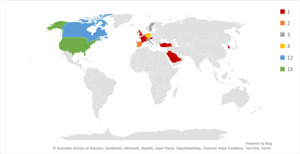
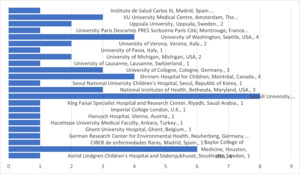


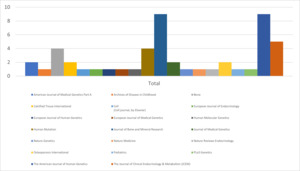


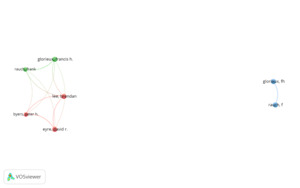
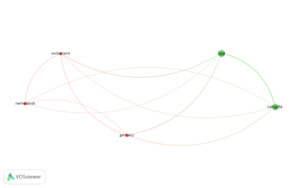
.png)


